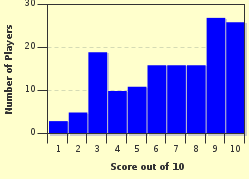Quiz Answer Key and Fun Facts
1. This Soviet military was promoted to the rank of Marshal of the Soviet Union in 1943, during his tenure as Chief of the General Staff ('Stavka'). In February 1945, he was appointed commander of the 3rd Belarussian Front, which invaded East Prussia. After victory over Germany, he led the successful assault against Japanese troops in Manchuria and Korea during operation August Storm.
2. This early companion of Stalin from the Russian Civil War era was appointed People's Commissar for Defence in 1934 and Marshal of the Soviet Union in 1935. He displayed monumental incompetence during the Winter War against Finland in 1939-1940. He was replaced by Stalin himself as Defence Commissar.
3. When this military commander became Marshal of the Soviet Union in 1935 at age 42, he was perhaps the man with the most modern vision of warfare in the Red Army. His strategy of deep operations using armor and aviation was slowly adopted by the Red Army through the 1930s. However, he was purged and executed during the infamous Moscow trials in 1937.
4. As head of the Central Front during the German offensive of 1941, he was forced to retreat all the way to Moscow. In 1942, he faced a serious setback during the battle of Kharkov, when he failed to break the German advance. He was then retired from frontline duty.
5. Born in Georgia in 1879, an early revolutionary in the Russian Revolution, companion of Lenin, in the 1920s this man became the most powerful man in the Soviet Union as Secretary General of the Communist Party. His nomination as Marshal of the Soviet Union in March of 1943 was political.
6. He was a field commander of extraordinary skill and bravery, who was responsible for halting the German advance on Moscow in 1941, planning Operation Uranus which trapped the 6th German Army in Stalingrad in 1942, and lifting the siege of Leningrad in 1944. Holding every possible distinction in the Soviet Union, he was also inducted to the Order of the Bath in the United Kingdom and to the Legion of Merit in the USA.
7. An extremely gifted military commander of Polish origin, his armies crushed the remainder of the Sixth German Army at Stalingrad. He became leader of the First Belarussian front after showing outstanding leadership during the Battle of Kursk. He then led his armies through Belarus, Poland, Prussia, all the way to Mecklenburg. By then he had become the 14th Marshal of the Soviet Union.
8. This Russian field commander came to preeminence as commander of the First Ukrainian Front, which swept through the Ukraine, then Poland, Belarus and Czechoslovakia. His units were the first to enter Berlin in 1945. He then linked with Patton's 3rd Army in Torgau, and then moved south to liberate. Prague. He had been made a Marshal of the Soviet Union in 1944.
9. This commander of Armenian origin was the first non-slavic Soviet general to lead an Army Front during the Great Patriotic War, namely the 1st Baltic Front. In 1944, during operation Bagration, his armies swept through Belarus, and then through Latvia and Lithuania. He was named Marshal of the Soviet Union in 1955.
10. This little-known Soviet field commander held the German advance in the Pripiat marshes in Belarus at a critical moment in 1941 as head of the Volkhov Front. He then helped to relieve Leningrad from the German siege. In 1944, he was transferred to the Karelian Front, in which he was faced with strong Finnish resistance. He was named Marshal of the Soviet Union in 1944.
Source: Author
El_Raton
This quiz was reviewed by FunTrivia editor
bloomsby before going online.
Any errors found in FunTrivia content are routinely corrected through our feedback system.


